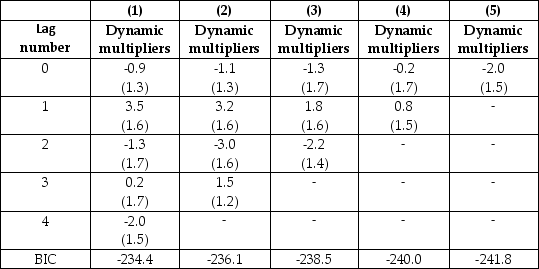One of the central predictions of neo-classical macroeconomic growth theory is that an increase in the growth rate of the population causes at first a decline the growth rate of real output per capita,but that subsequently the growth rate returns to its natural level,itself determined by the rate of technological innovation.The intuition is that,if the growth rate of the workforce increases,then more has to be saved to provide the new workers with physical capital.However,accumulating capital takes time,so that output per capita falls in the short run.
Under the assumption that population growth is exogenous,a number of regressions of the growth rate of output per capita on current and lagged population growth were performed,as reported below.(A constant was included in the regressions but is not reported.HAC standard errors are in brackets.BIC is listed at the bottom of the table).
Regression of Growth Rate of Real Per-Capita GDP on Lags of Population Growth,
United States,1825-2000
 (a)Which of these models is favored by the information criterion?
(a)Which of these models is favored by the information criterion?
(b)How consistent are these estimates with the theory? Is this a fair test of the theory? Why or why not?
(c)Can you think of any improved data to test the theory?
Definitions:
Saving Rate
The portion of income that is not spent on consumption but is saved or invested for future use.
Gold Standard
A monetary system where a country's currency or paper money has a value directly linked to gold; countries agree to convert currency into a fixed amount of gold.
Fixed Exchange-Rate
A regime under which the government or central bank ties the official exchange rate to another country's currency or the price of gold.
Capital Account
A national account that shows the net change in asset ownership for a country. It includes foreign investments and loans.
Q3: The biggest conceptual difference between using VARs
Q3: For quasi-experiments,<br>A)there is a particularly important potential
Q5: The correlation between X and Y<br>A)cannot be
Q5: The r and c notations used in
Q10: One of your peers wants to analyze
Q11: Television networks frequently run public opinion polls
Q12: The candy company that makes M&M's claims
Q30: The following two graphs give you a
Q41: When Xt is strictly exogenous,the following estimator(s)of
Q42: In a simple regression with an intercept